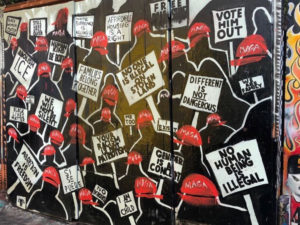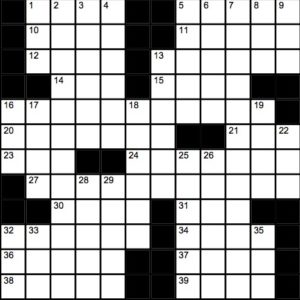Nestled between Mission and Valencia Streets, in the heart of San Francisco’s Mission District, lies a surprise technicolor art destination: Clarion Alley.
Over 1,000 murals adorn San Francisco, the vast majority painted on the streets of the Mission District. Street art has been a ubiquitous part of the neighborhood’s identity long before Clarion’s inception. Some of the Mission’s oldest murals, located in Balmy Alley, date back to the early 1970s, when the locale came to serve as a place for primarily Latino artists to discuss political and economic upheaval in Central and South America.
Clarion Alley murals began in 1992 when a group of local organizers and artists-in-residence aimed to create a new forum for political and aesthetic expression with subject matters beyond the scope of Balmy Alley. Clarion Alley Mission Project’s (CAMP) mission is to use “visual messaging” to “provide a powerful vehicle for supporting political, economic, and social equity and dismantling intersectional oppression.” True to this message, many murals address subject matters that concern the Mission’s role in the ever-changing social and political landscape of San Francisco. The murals cover, among other things, gentrification, queer rights, police brutality, and feminism.
Saif Azzuz, 29, a North Bay native who has been working directly with CAMP for two years, painted two “No Ban on Stolen Land” murals in response to President Trump’s recent attempted ban of immigrants from Muslim-majority countries.

Azzuz explains, “As an Arab (Libyan) and Native American (Yoruk) I was caught directly in the middle of Trump’s flawed and morally bankrupt policies,” Azzuz says. He used the slogan “No Ban on Stolen Land” to communicate the idea that “you can’t ban one group from land that was very recently stolen from another group.”
Clarion Alley is a haven for political and creative expression, a forum to rally the community and a way to expose the average passer-by to the most pressing issues in our society.
Sirron Norris, a local artist and longtime contributor to the alley, is quick to call into question the alley as a meaningful forum for art due to its accessibility to the average passerby, referring to Clarion Alley as “short attention span theater.”
His complaint does not lie with the messages conveyed in the alley, but how “the ideas expressed in the alley are more ephemeral or temporary, versus traditional murals, which speak to generations.”
Azzuz, however, sees this supposed shortcoming as one of the alley’s major benefits. He explains how his own art is different from his public work or “street art.” While Norris sees the explicitness of many murals “devoid of nuance,” Azzuz sees it as a necessary, or even integral aspect of his murals.
“When I am working in a public sphere, I try to make work that is political and easy for the viewer to access. Some may call it didactic, but I find it easier to be direct when I do something meant for all audiences,” says Azzuz.
Azzuz’s view most closely resemble’s CAMP’s original goal in creating the alley– to create a forum for as many artists as possible to convey their beliefs to a wide range of audiences.
With the uptick in social media posts depicting the alley comes a new type of viewership. Hordes of visitors take photos in front of the murals to post on social media, a phenomenon Norris feels has broader implications. He feels that social media has largely “corrupted” the guerilla roots of street art, reducing it to “only the visuals.”
Azzuz, a younger artist on the scene, argues that “social media is a powerful tool for spreading social and political awareness. For instance, [No Ban on Stolen Land] got posted multiple times, which created an audience in the tens of thousands.” The benefit of this, Azzuz says, is it “allows something that is stationary to become mobile in the.”
As for the future of Clarion Alley, Azzuz and Norris both plan to continue contributing in their spots —Azzuz with a new mural and Norris with new iterations of his blue bear, a piece which has occupied the corner of Valencia and Clarion for over 15 years.
“My only hope for Clarion Alley is that it continues to exist and isn’t forced out by the influx of condos and gentrification,” Azzuz said.
Since 2000, the median price of houses sold in the Mission has climbed from $360,000 to $1.2 million, a shift that has left many long-time tenants priced out of the neighborhood. This makes non-profit projects such as Clarion Alley particularly vulnerable to displacement or eviction.

Another pertinent issue is the increasing instances of vandalism of the alley. The exposure to the public, one of the mural’s greatest assets, unfortunately also gives ample chance for opponents to deface them. The latest vandalism occurred Friday October 15, when an unidentified person defaced “almost half” of the murals in the alley, according to an account by Azzuz.
Among the targets of the attack, which covered murals with dozens of Make America Great Again hats in bright red paint, was one of Azzuz’s works of art. A collaboration with several other artists, it depicts a group of anonymous protesters. Artists were quick to respond, however. Many of them repaired their work as early as the following morning.
In the future, it will be interesting to see whether Clarion Alley, and other grassroots art spaces like it, persist in the increasingly hostile environment as areas of free expression, discourse, and creativity.







